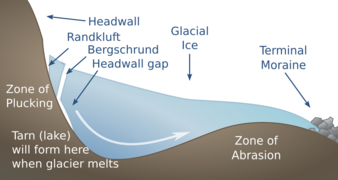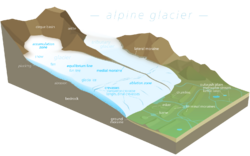Earth:Glacier head
A glacier head is the top of a glacier. Although glaciers seem motionless to the observer they are in constant motion and the terminus is always either advancing or retreating.[1]
On a glacier, the accumulation zone is the area above the firn line, where snowfall accumulates and exceeds the losses from ablation, (melting, evaporation, and sublimation). The annual equilibrium line separates the accumulation and ablation zone annually. The accumulation zone is also defined as the part of a glacier's surface, usually at higher elevations, on which there is net accumulation of snow, which subsequently turns into firn and then glacier ice. Part of the glacier where snow builds up and turns to ice moves outward from there.
The glacier head is the highest upslope edge of an alpine glacier or the upslope end of the zone of accumulation. The head of the glacier comes up against a steep bedrock cliff called a cirque headwall[2]

Movement and ice loss
The head can come away from the cirque in a downslope movement which can create a large crevasse called a bergschrund. This crevasse can be a major obstacle for mountaineers. The existence of a bergschrund is evidence that ice mass has pulled away from the cirque.[2]
A shrinking glacier thins faster near the terminus than near the head, which explains why glaciers retreat up-valley and the glacier head stays in place[3]
The speed of erosion or accumulation is partly dependent on a shape factor which is the ratio of the change in thickness at the glacier head to the change in the thickness at the terminus.[4]
Notes
- ↑ "Glacier Features: Glacier terminus | National Snow and Ice Data Center". https://nsidc.org/cryosphere/glaciers/gallery/terminus.html.
- ↑ 2.0 2.1 Monroe, James S.; Wicander, Reed (January 2014). The Changing Earth: Exploring Geology and Evolution. p. 526–536. ISBN 9781285733418.
- ↑ "USGS Fact Sheet 2009–3046: Fifty-Year Record of Glacier Change Reveals Shifting Climate in the Pacific Northwest and Alaska, USA". https://pubs.usgs.gov/fs/2009/3046/.
- ↑ "Glacier response time". http://www.antarcticglaciers.org/glacier-processes/glacier-response-time/.
attribution:Contains text copied from Accumulation zone and Bergschrund and Terminus.
 |



